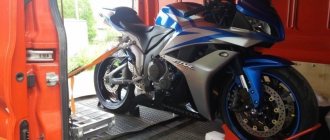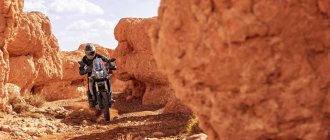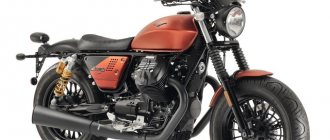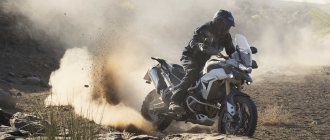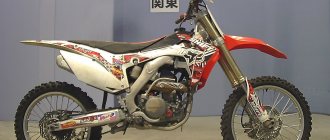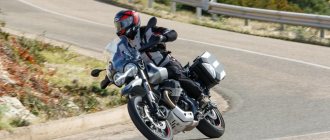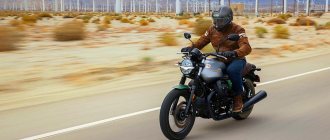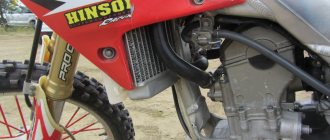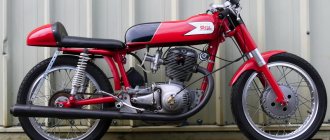How to drive a rally raid?
How to get to the big races? World Championship? Africa Flight? Dakar? "Silk Road"? A very common question that cannot be answered in a nutshell. Behind the simple phrase “Dakar participant and finisher” there is much more hidden than meets the eye. Many people are not aware that money alone is not enough to participate in the Dakar; every newcomer must have at least two races in the world championship or the Dakar series (this includes large private races under the auspices of ASO and the Dakar brand) in their track record. , based on the results of which applicants for participation are selected.
Probably, someone will be able, without wasting money, to immediately start spending 20 thousand euros per stage of the World Championship, gaining experience at the highest level, but this is unreasonable from the point of view of not only finances, but also safety. Therefore, I would advise starting a gradual upward movement from the first steps and not jumping over flights of stairs. Unfortunately, in Russia we have a small selection of rally-raid competitions. Only two options come to mind: “Moto Rally Cup” (Moto Rally Cup/MRC) - an interesting series of races for beginners led by experienced car navigator Alexey Kuzmich, and the official Russian championship in rally raids, which, unfortunately, is not inhabited by the most the best times both in terms of the composition of participants and the length of the tracks.
If you have decided to try your hand at rally raids, bought a suitable motorcycle and attached a rewind for the road book to it, feel free to search the MRC calendar online and accelerate to your first races. A friendly atmosphere, loyal attitude of the organizers, interesting routes, advice and assistance from experienced riders, plus the necessary basic skills in working with a road book are provided to you. Once you feel more confident and the roadbook scribbles suddenly begin to transform into something meaningful, feel free to move on to the next level.
In this case, you have a choice: either go to several stages of the Russian Championship, or choose one inexpensive foreign private race, of which there are a great many held during the season. Some of my friends complain: they say, we are not so rich to go to international competitions, so our ultimate dream is 300 km of SS in three days of racing in the Russian championship. In fact, going “there” is sometimes cheaper, so you shouldn’t be afraid of traveling abroad at all. Let's take the seven-day race in Albania as an example.
“Rally of Albania” has been held for 13 years in a row and annually brings together from 65 to 150 motorcyclists. The linear route of the race, more than 2000 kilometers long, is scheduled for seven fighting days, so taking into account arrival and departure, administrative and technical checks, you need to budget about ten days for the entire event. To participate, you do not need to have an expensive international license from the FIM, and no one will even ask for our national license from the MFR, so apart from your license, documents for a motorcycle, a passport and two photographs from the documents, you will not need anything. Separately, you will have to pay 25 euros for mandatory insurance from the organizers. The entry fee of 550 euros includes motorcycle insurance for the duration of the race, transportation of luggage from camp to camp, medical care, transportation to the hospital, space for a tent/car at the bivouac, rental of a navigation system and trekking control, evacuation of broken equipment to the camp, road book for the participant and his assistance, daily route map.
70% of Albania's territory is mountainous and forested, so the main part of the race takes place in the mountains. About half of the liaisons also run on the ground and sometimes the surface does not differ much from the special sections. Unlike the classic stages of the World Cross Country Rally Championship, where the average speed can exceed 100 km/h, the race in Albania is closer to the classic mountain enduro and the average speed does not exceed 40 km/h. Therefore, most of the participants take to the start line on light power bikes with an engine capacity of 250 to 500 cm3. For special connoisseurs of large two-cylinder touring motorcycles such as the Honda Africa Twin, KTM Adventure or BMW GS 1200, there is a separate class. Last year I rode the entire route on a KTM Adventure 990 and I can say that it’s a dubious pleasure, especially for a girl. There are eight different classifications in total in the race, if you choose a lighter motorcycle, you can enter one of seven: M-1 (up to 450cc), M-2 (450cc-600cc), M-3 (over 600cc single-cylinder), M-4 ( over 600cc two-cylinder), M-5 (Veterans up to 450cc. Date of birth before 01/1/1967), M-6 (Veterans over 450cc. Date of birth before 01/1/1967), M-7 (Women's classification), M-A (passing routes according to a specific time schedule). Since the speeds in Albania are low, the special sections are relatively short, which allows you not to pile a bunch of additional tanks on the motorcycle and get by with a standard larger tank from the factory tuning catalogue, even 12 liters is quite enough. From navigation equipment, it is enough to rewind the road book attached to the steering wheel on two extensions, and two odometers, the main one and the spare one. There is no need to install expensive fasteners for navigation, which is required for the Russian and World Championships in Albania.
With accommodation and food, everything is also very democratic. The most expensive hotel with a pool and all the amenities in Tirana costs about 50 euros for one or 60 euros for two. In smaller cities there are simpler hotels, and prices do not exceed 30 euros per night, including breakfast. Those who want to save on housing can live in a car in the bivouac, which is usually located next to the main race hotel. In the most luxurious restaurant, lunch with wine, steak and cheese costs no more than 15 euros per person, but if you don’t go too fancy, you can easily fit in 5-7 euros.
With all the above advantages, there is one big disadvantage to the Albanian Rally, it is not close to get to it from Russia, about 3000 kilometers one way, and here several options arise. You can feel like a factory pilot and not bother with your equipment and motorcycle. You negotiate with a foreign team and rent from them a ready-made motorcycle with full technical service. This pleasure will cost about 1,800 euros per week, but you relieve yourself of a lot of difficulties, and besides the plane ticket and your personal belongings, you don’t need to worry about anything else. If you drive your own car, you will have to pay about 700 euros for fuel (at the rate of 10 liters per 100 km), 200 euros for accommodation and meals along the way, 150 euros for the car and mechanic, and some other small things. The total will be about 1100 euros. And if you take like-minded people with you and divide these travel expenses in half or even three, the amount will be significantly reduced. In my opinion, this option is the most budget-friendly and, oddly enough, fun.
Overall, the race in Albania is very democratic. For the most part, the participants are amateurs from European countries with completely different levels of skiing, from very fast to very slow, so even if you are not the most confident rally driver, you will not feel uncomfortable in this company. The standard time for the rally is early June, the average temperature is about 25 - 30 degrees. Since the area is mountainous and there is a sea nearby, the weather can change during the day from sunny to rainy and back several times, but this only adds to the variety. I remember Albania for its beautiful landscapes and fantastic clouds that cling to the mountain peaks and swirl in bizarre shapes. You definitely need to be prepared for the fact that every day on the way you will have to cross several fords through mountain streams, so you need to take with you shoe dryers or spare liners, if they are provided for in the design of the motorcycle boots. A raincoat and a spare set of uniforms with thermal underwear are also required. Another necessary thing is a belt bag where you can put your phone, money, food and other items necessary on the road. Just in case, I took with me a spare lens for glasses. On my Oakley airbrake it literally changes in seconds and sometimes it was easier to do just that than to rub the dirt with a rag while scratching the glass. Since the track is as close as possible to enduro, I recommend driving not in a rally jacket, but in an ordinary jersey with full protection - a turtle neck underneath.
In any case, if anyone has any questions, I am always ready to answer them on my pages on social networks. Squeak, don't be shy. @ nifontova 13
V 10 points > August 23, 2021 19:20 Anastasia Nifontova
The 690 I purchased last spring behaved normally for about a year, and then I wanted to go rallying.
I had to go... Ours win rallies not because the trucks are powerful, but because they have roads like ours
There was no sign of any rally in Belarus, so I started looking in Russia. I remembered Vanya Li’s posts, saw that in past years there was still a Russian championship, and people raced in Astrakhan, but now almost everything has disappeared. In addition to the amateur Moto Rally Cup, which is made by Alexey Kuzmich. He also lays out routes, draws road maps and shares his experience with beginners. The cup consists of five stages, which take place from May to October in different places in Russia. The final race of this season took place near Kamensk-Shakhtinsk in the Rostov region - 1550 km from Minsk. My friend Dima and I loaded our combat KTMs into a trailer, on Wednesday evening we drove towards the M4 Don highway and on Thursday at midnight we were already in place - at the Skazka camp site, where we were accommodated in a “five-seater suite” with one room and two sofas . We woke up to the screams of geese freely grazing around the camp site, and the screams of the administrator, who wanted to limit this freedom of theirs.
Prologue
In a rally, everything happens quickly and according to a strict schedule, but the first day was relatively free. Until 14.00 - registration, and legends (a paper scroll with symbols of the route), GPS tracker to track the result and technical control in a specially designated area. There they checked for me:
- Are all the controls of the motorcycle working properly - primarily the headlight and brake light;
- whether the motorcycle is covered with stickers from the sponsors of the competition. A huge sheet of stickers was given to everyone in advance;
- is the start number readable?
- do you have all the necessary protection (helmet, motorcycle boots, turtle, knee pads and neck protection is a must);
- Is there a supply of water, food (Snickers), a first aid kit.
The inspector stamped the appropriate piece of paper and sent me off to prepare further.
The essence of the race, to simplify it, is to reach the finish line according to legend with the best time, without getting lost anywhere, without getting fines, without breaking yourself and your motorcycle, and collecting all the checkpoints. For navigation in this rally, a list of points with coordinates and a legend were used. If you don’t have a device for rewinding the legend, you can draw the route yourself or go directly, and beginners are given the entire track. But then the interest disappeared, and I agreed to rent a tower for the race. There was no confidence that it would fit - the kit was designed for the KTM 450, and I have a 690.
6 clamps and a few bolts did the trick - I now have navigation, complemented by my Chinese navigator on Android. The small rectangular device at the top of the photo is an ICO GPS navigator, which is used by many rally drivers. It is controlled by just three buttons on the steering wheel and shows everything you need - speed, course, mileage, time. If the actual mileage does not coincide with the legend, you can use the buttons to rewind it and move on. Professional racers also have additional screens - a course repeater and a spare odometer, as well as a special Unik rally navigator. But for us, everything is simpler for now.
This time there was no official opening with a ceremonial passage through the arch and the announcement of the riders - although there is usually one in this series. We went straight to the liaison to the starting point. The time for more than 20 kilometers of run is limited to thirty minutes, and you need to arrive at the pre-start zone exactly on your own minute - otherwise you will be fined. The Chinese navigator took me to fields with cows instead of a normal road. Four minutes late is a great start!
Still trying to figure out what was going on, where to go and what to do, I received the control card and, following 8 other riders, finally took off. There was no time to get used to the navigation controls, and I had to figure it out on the go, at speed. Also, dodge cows and tinted Priors with mushroom pickers. It turned out to be easy to read the legend—that’s how it seemed to me until its first discrepancy with reality. If you miss a fork or a landmark, you have to return to the same point, rewind the legend and mileage to the required distance, and start from that moment again while others rush past. I must admit, everyone got lost - due to a small discrepancy in the roadmap. And my friend, who was driving not according to the legend, but along a independently drawn track, overtook everyone not only in his class, but also in the “Sport” class. The prologue lasted only 17 kilometers and all the action took a little longer than you are now reading this article. And it's all? — I thought and went back to the base to realize what had happened.
In the evening after dinner there was a briefing - we all gathered in one room and listened to the features of tomorrow's route. In total, about twenty motorcycle racers gathered, mostly from Russia. Me, Dima and several guys from Kazakhstan made the event international. We got half a chicken for dinner, road maps for the next day and instead of sleeping we went to service the motorcycles and mark the maps.
I googled how to do it - everything seems clear. Marking the DC helps speed up reading; this is done with bright multi-colored markers. Everyone makes the markings for themselves, as is more convenient, and I followed the general rules - green marked large distances between markings, red - up to 300m, where you need to slow down and be more attentive. I marked obstacles in red, but all this will still need to sit down and figure it out.
Day 1
A new morning and a new race - this time two laps of a special stage 85 km long on sandy dirt roads and dunes! I was most worried about the dunes because I had never tried anything like this. I just saw on video how cars get buried in them and trucks overturn in Dakar.
Everything went great with navigation today - it’s so good to drive when all the landmarks and distances match! The main thing is not to accelerate too much, so as not to miss a turn, and not to be distracted by others. Everything went well until the dunes. Usually, during rally raids along the dunes, you drive on courses - you take a course at 234 and drive to the point - either directly, if you can, or maneuvering between the dunes. We had the coordinates of the point, and I used the drawn route directly. More precisely, I tried to use it.
I took the first point according to legend, but then something went wrong. Instead of showing the direction, the navigator tried to find the road, rearranged the route five times per minute and behaved inappropriately. You are driving in one direction, the map is scaled, the point goes out of sight, after 2 minutes you stop, zoom out on the map - you are not at all where you need to be. Yes, I had to stop, breathe and calmly figure everything out. But there was a sense of urgency: the others were passing by. Therefore, I poked around in the dunes like a blind kitten, groped my way out of the sandbox directly, and directly through the forest with fallen logs I looked for a further route. I even knocked my motorcycle over a couple of times and spent energy lifting it. Apart from the problems with navigation, driving through the dunes on my 690 turned out to be easy - the sand was dense, and from acceleration it was possible to take even the highest of them head-on. The main thing is to stop in time. Sometimes you fly out onto a small dune, and behind it is a cliff! The slope is 70 degrees and three meters down. You can go down slowly, but you wouldn’t want to jump out into something like that.
We were given 3 hours of control time for these 85 kilometers. I spent them all, without collecting a good part of the points. Frustrated, through some wilds and sands, I drove either according to the legend or according to the navigator to the finish. And I thought that I didn’t meet it on time and they might not let me in any further. But they let me in! Even with a fine. There was a regulated half-hour break between the stages, during which we managed to lose our gloves, refuel the motorcycle, rewind the legend to the beginning, break a nail, find gloves, fiddle with all the settings in the navigator and set them to normal for navigation directly to the point.
The second round turned out great! I caught up on time while I got to the dunes along the already familiar route. And using the “compass” I easily took half of the points, enjoying every second. You cut through the sand, there is no one around, only natural beauty, you and a motorcycle. How important it is to know your equipment down to the smallest detail... The sun began to set, so I had to skip a few points and move towards the finish. At the end of the day - 9th place out of 18 participants and dissatisfaction with myself (I could have figured out the navigation right away, you damn humanist!). Again a briefing, receiving a recreation center, a night of marking and sleep.
Day 2
The last day was fast and technically easy. The main thing is not to slip on the ground, hardened like concrete, and again, not to get lost. My friend was unlucky in this regard, and had to cross reclamation ditches and jump over a huge pile of manure. But I got used to navigation, got a little lost, got a fine for exceeding the speed limit in a section (yes, 1 kilometer also counts) and ultimately took 8th place. I can’t call it success, but at least I understood what rally raids are. Not only speed, but also navigational work, and the ability to quickly calculate everything and behave correctly in the right situation.
Participants - Nastya and the men
While we were driving back, I had time to cut down expenses. The costs per person were as follows (in Russian rubles): 7000 rubles - rent of the tower. The toad and I strangled each other for a long time, but still decided to try what it was. It was possible to drive using the navigator without it. 9000 rubles - diesel fuel for a car and gasoline for a motorcycle 3000 rubles - accommodation in a camp site on site, +2000 rubles for overnight stays and food on the road 6000 rubles +2000 rubles - entry fee 1100 rubles - food on site for three days
Total 31,100 rubles - $490 for a five-day adventure, if you count the road as part of it. I will now assemble my tower to eliminate this expense item. Yes, rallying remains a sport for, to put it mildly, the wealthy. But damn, it was great. I will look at options in Europe for next year...
PS And near Lipetsk, in the Kudykina Gora park, these orange sheep graze.
Moto Rally Cup
On May 30-31, 2015, a two-day stage of the Moto Rally Cup, the Andreapol-2015 rally-raid, was held in Andreapol, Tver Region, which received the official status of a traditional race from the Russian Motorcycle Federation.
At the start in the Moto Sport 450, Moto Grand Enduro, Moto Side and Moto-amateur motorcycle classifications, participants ranged from beginners who went to a real sports event for the first time to masters of sports, honored international athletes from Moscow, the Moscow region, Astrakhan and Yaroslavl.
The start of the first race of the 2015 Moto Rally Cup season was given by: the head of the Andreapol region Nikolai Nikolaevich Barannik, participant of the World Cup in cross-country rallies Vyacheslav Pashchenko, international master of sports, participant and prize-winner of the Dakar and Silk Way rallies Alexey Kuzmich, Russian motorcycle racer, participant of the Africa Eco Race marathon rally Anastasia Nifontova.
After the ceremonial presentation of the athletes and a ride along the podium, the riders went for a short prologue to the cross-country track, specially built by Vyacheslav Pashchenko for training motorcyclists near the village of Borzovo, 60 kilometers from Andreapol. In the pouring rain, motorcycle racers delighted numerous spectators with acrobatic jumps and miracles of off-road motorcycle aerobatics on slippery ramps.
Immediately after the prologue, the athletes were waiting for the forest special stage “Quick Warm-up” in the area of the village of Goritsy - with high-speed graders and winding forest roads 40 kilometers long. The first day of the first stage of the Moto Rally Cup went without losses, all riders reached the finish line.
The best times of the first day according to the results of the first day were shown by Viktor Zavyalov (Moto Sport 450, Yaroslavl), Yaroslav Knorozok (Moto Grand Enduro, Moscow), Andrey Lvov/Dmitry Kurkov (Moto Side, Moscow), Svyatoslav Kuzmich (Moto-amateurs, Lyubertsy).
On the second day, the organizers prepared a special stage with a beautiful name and the romantic name “Forest Fairy Tale”, 70 kilometers long; the athletes covered it three times, so the total length of the second two days of the competition was 260 kilometers.
The first to start the second racing day is the leader of the Moto Sport 450 standings based on the results of Saturday’s special stages – Viktor Zavyalov from Yaroslavl. His main rivals - representatives of the Moscow region Alexey Popov, Alexey Naumov and Astrakhan resident Dmitry Meremyanin - got the role of catching up. And the experienced Alexey Naumov from Kolomna performed this role best of all. He arrived first, and after two racing days he became the winner in the Moto Sport 450 sports classification!
In the heavy motorcycle class Moto Grand Enduro, the best time was shown by Muscovite Mikhail Orekhov. Among the amateurs who competed on a wide variety of motorcycles, Vladislav Yumashev (Moscow) became the fastest. The only Moto Side crew on a motorcycle with a sidecar – Andrey Lvov and Dmitry Kurkov – successfully finished and were deservedly awarded. The team Independence MR Peter won the team competition.
The weather on the second day of the competition did not bring any surprises, but the rains the day before thoroughly washed out the track and it was very slippery in places. But the diversity of the “Forest Fairy Tale” surface - smooth, high-speed graders and winding, muddy paths - allowed the athletes to win back where their technique allowed them to go faster. The participants rated the organization of the first stage of the Moto Rally Cup and the Andreapol track as “excellent”.
Alexey Naumov (Kolomna): “The Cup was organized excellently and professionally. This is not surprising, because the organizer is a professional athlete and has been racing for a long time. I haven’t performed in Russia for a long time, I really enjoyed it. Thanks to the people of Adreapol for the most interesting stage.”
Viktor Zavyalov (Yaroslavl): “The track was very interesting and varied, there were many treacherous puddles and bridges, on one of which I fell into a gap made of logs and thought that I would stay there! But someone from above helped me, I managed.”
Yaroslav Konorozok (Moscow): “The track really was fabulous, but in the muddy sections the 450s left me, and I was doing race walking with a motorcycle. In any case, this is excellent training and the necessary experience to ride better in the championship - faster, better and more beautiful. And fall more beautifully.”
Alexey Kuzmich, race organizer (Lyubertsy): “We are very pleased with the route that we have compiled for our participants. The two-day rally-raid format allows participants to get the most out of the track, demonstrate their skills, gain the necessary experience and, most importantly, enjoyment.”
The organizers express their gratitude to the Head of the Andreapol region, Barannik Nikolai Nikolaevich, as well as partners and Sponsors “Andreapolnefteprodukt”, “Business Automation” for their help and support in resolving many issues regarding the organization and conduct of the competition.
The race was supported by: Oltex RaceEvent, Husqvarna, Red Racing Group, Avenda, Andreapolskaya Voda
Information partners: Motogonki.ru, RedSleds,
On May 30-31, 2015, a two-day stage of the Moto Rally Cup, the Andreapol-2015 rally-raid, was held in Andreapol, Tver Region, which received the official status of a traditional race from the Russian Motorcycle Federation.
At the start in the Moto Sport 450, Moto Grand Enduro, Moto Side and Moto-amateur motorcycle classifications, participants ranged from beginners who went to a real sports event for the first time to masters of sports, honored international athletes from Moscow, the Moscow region, Astrakhan and Yaroslavl.
The start of the first race of the 2015 Moto Rally Cup season was given by: the head of the Andreapol region Nikolai Nikolaevich Barannik, participant of the World Cup in cross-country rallies Vyacheslav Pashchenko, international master of sports, participant and prize-winner of the Dakar and Silk Way rallies Alexey Kuzmich, Russian motorcycle racer, participant of the Africa Eco Race marathon rally Anastasia Nifontova.
After the ceremonial presentation of the athletes and a ride along the podium, the riders went for a short prologue to the cross-country track, specially built by Vyacheslav Pashchenko for training motorcyclists near the village of Borzovo, 60 kilometers from Andreapol. In the pouring rain, motorcycle racers delighted numerous spectators with acrobatic jumps and miracles of off-road motorcycle aerobatics on slippery ramps.
Immediately after the prologue, the athletes were waiting for the forest special stage “Quick Warm-up” in the area of the village of Goritsy - with high-speed graders and winding forest roads 40 kilometers long. The first day of the first stage of the Moto Rally Cup went without losses, all riders reached the finish line.
The best times of the first day according to the results of the first day were shown by Viktor Zavyalov (Moto Sport 450, Yaroslavl), Yaroslav Knorozok (Moto Grand Enduro, Moscow), Andrey Lvov/Dmitry Kurkov (Moto Side, Moscow), Svyatoslav Kuzmich (Moto-amateurs, Lyubertsy).
On the second day, the organizers prepared a special stage with a beautiful name and the romantic name “Forest Fairy Tale”, 70 kilometers long; the athletes covered it three times, so the total length of the second two days of the competition was 260 kilometers.
The first to start the second racing day is the leader of the Moto Sport 450 standings based on the results of Saturday’s special stages – Viktor Zavyalov from Yaroslavl. His main rivals - representatives of the Moscow region Alexey Popov, Alexey Naumov and Astrakhan resident Dmitry Meremyanin - got the role of catching up. And the experienced Alexey Naumov from Kolomna performed this role best of all. He arrived first, and after two racing days he became the winner in the Moto Sport 450 sports classification!
In the heavy motorcycle class Moto Grand Enduro, the best time was shown by Muscovite Mikhail Orekhov. Among the amateurs who competed on a wide variety of motorcycles, Vladislav Yumashev (Moscow) became the fastest. The only Moto Side crew on a motorcycle with a sidecar – Andrey Lvov and Dmitry Kurkov – successfully finished and were deservedly awarded. The team Independence MR Peter won the team competition.
The weather on the second day of the competition did not bring any surprises, but the rains the day before thoroughly washed out the track and it was very slippery in places. But the diversity of the “Forest Fairy Tale” surface - smooth, high-speed graders and winding, muddy paths - allowed the athletes to win back where their technique allowed them to go faster. The participants rated the organization of the first stage of the Moto Rally Cup and the Andreapol track as “excellent”.
Alexey Naumov (Kolomna): “The Cup was organized excellently and professionally. This is not surprising, because the organizer is a professional athlete and has been racing for a long time. I haven’t performed in Russia for a long time, I really enjoyed it. Thanks to the people of Adreapol for the most interesting stage.”
Viktor Zavyalov (Yaroslavl): “The track was very interesting and varied, there were many treacherous puddles and bridges, on one of which I fell into a gap made of logs and thought that I would stay there! But someone from above helped me, I managed.”
Yaroslav Konorozok (Moscow): “The track really was fabulous, but in the muddy sections the 450s left me, and I was doing race walking with a motorcycle. In any case, this is excellent training and the necessary experience to ride better in the championship - faster, better and more beautiful. And fall more beautifully.”
Alexey Kuzmich, race organizer (Lyubertsy): “We are very pleased with the route that we have compiled for our participants. The two-day rally-raid format allows participants to get the most out of the track, demonstrate their skills, gain the necessary experience and, most importantly, enjoyment.”
The organizers express their gratitude to the Head of the Andreapol region, Barannik Nikolai Nikolaevich, as well as partners and Sponsors “Andreapolnefteprodukt”, “Business Automation” for their help and support in resolving many issues regarding the organization and conduct of the competition.
The race was supported by: Oltex RaceEvent, Husqvarna, Red Racing Group, Avenda, Andreapolskaya Voda
Media partners: Motogonki.ru, RED SLEDS, ex-roadmedia.ru
Moto Rally Cup is a series of rally-raid competitions on motorcycles, ATVs and buggies. The race has the official status of the Russian Motorcycle Federation.
Photo
Moto Rally Cup https://yadi.sk/d/9497_drxgzUsC
https://ready2rally.ru
Moto Rally Cup is a series of rally-raid competitions on motorcycles, ATVs and buggies. The race has the official status of the Russian Motorcycle Federation.
Photo Moto Rally Cup https://yadi.sk/d/9497_drxgzUsC
https://ready2rally.ru
Cross country moto rally
Cross-country motorcycle rally is a type of long-distance multi-day motorcycle race over rough terrain. Motorcycles compete in 6 subgroups: lightly tuned with an engine capacity of up to and more than 450 cubic centimeters, seriously tuned with an engine capacity of up to and more than 450 cubic centimeters, and ATVs with an engine capacity of up to and more than 500 cubic centimeters. Also, at most competitions, winners among women and juniors are identified separately. The competition is divided into several sections, which athletes complete in one day. The points received at the polling stations are summed up and the winners are determined. In some rallies, such as the Dakar, the winner is simply the one who finishes first.
This extreme sport should not be confused with American cross-country tours, such as the Victory Cross Country Tour, in which Americans, gorged on hamburgers and drunk on beer, languidly chopper along the perfectly paved endless roads of their homeland.
There are 3 types of cross-country rallies: - Marathon - duration from 6500 to 30 days - Rally raid - mileage up to 6500 and time up to 10 days - Baja - mileage up to 1200 km and time up to 5 days
In order to reduce the costs of holding these motorcycle races, they are usually held as part of a separate motorcycle competition class for motorists. Moreover, the number of cars taking part in competitions is often several times greater than the number of motorcycles. the “Kagan’s Gold” rally that took place in April 2021 Ivan Lee locdog took part , about 50 cars, 4 motorcycles and a couple of quads competed.
The most significant event held by the International Motorcycle Association (Fédération Internationale de Motocyclisme (FIM) is the Cross-Country Rallies World Championship . The championship stages are held in different countries of the world. Below is the 2021 rally-raid calendar: 02-07/04/2016 Abu Dhabi Desert Challenge UNITED ARAB EMIRATES 17-22/04/2016 Sealine Cross-Country Rally QATAR 02-07/06/2016 Sardegna Rally Race ITALY 21-27/08/2016 Atacama Rally CHILE 01-07/10/2016 OiLibya Rally MOROCCO
In the desert stage of the Championship in Abu Dhabi, which took place in early April, 42 bikes and ATVs, as well as 62 cars and buggies took part. For the 26th time, these competitions were held for motor racing athletes and for the 21st time for motorcyclists, and only for the 17th time within the framework of the FIM. Over the course of 6 days, the athletes covered 250 kilometers along the dunes of the Liwa Desert. Along the route, participants had to face a sandstorm and strong winds.
The International Moto Association also holds the annual Baja World Cup FIM BAJAS WORLD CUP . This year's schedule is below: 23-26/06/2016 Italian Baja ITALY 22-24/07/2016 Baja España Aragon SPAIN 11-14/08/2016 Hungarian Baja HUN HUNGARY 09-10/09/2016 Baja TT de Idanha- a-Nova PORTUGAL
The most famous marathon rallies include the annual transcontinental race Dakar Rally . Founded in 1978 by the Frenchman Thierry Sabin, it was first called Paris-Dakar, but after the ban by the Parisian authorities, due to inconvenience for residents, it began to launch from other French cities and lost the word Paris in the name. It was canceled in 2008 due to the threat of terrorist attacks, and then moved from Europe to South America in 2009. To this day, Dakar continues to be the most difficult and famous cross-country marathon. It involves trucks, cars, motorcycles and ATVs. The winners are determined in three categories: personal championship, nations championship and constructors' championship.
This year the race started on January 3 in the capital of Argentina, Buenos Aires. Russian riders have not taken part in trophies on motorcycles for a long time, but Sergey Karyakin will compete on an ATV for several years in a row. In Dakar, both professional athletes and teams compete, as well as amateurs who have applied, who are usually recruited more than professionals. The route passes through canyons, salt marshes, impassable sands and high mountain areas up to 4000 meters above sea level.
Other cross-country rallies include the Budapest-Bamako TransAnatolia Rally Raid, Rallye des Pharaons, Central Europe Rally, Asia Cross Country Rally, Spanish Baja, Raid De Himalaya and Klang Valley Rally Raid. Russia also hosts the Cross-Country Rally Championship and Cup.
Schedule of stages of the Russian Cross-Country Rally Championship and Cup: 1st stage - 01/23-24/2016, Kolomna, Baja "Snow Storm" 2nd stage - 06/10-12/2016, Volgograd, rally-raid "Great Steppe - Don" 3rd stage - Dates to be confirmed, Nizhny Novgorod, Bakha "Nizhny Novgorod" 4th stage - 03-07.09.2016, Volgorad, Elista, Astrakhan, rally-raid "Great Steppe - Silk Road"
How to get to the Dakar rally marathon - how much and what to pay for, recommendations from Anastasia Nifontova
Every year, when the next Dakar starts, questions arise - how to get to the main rally marathon on the planet, because not only professional factory racers participate in it. Before Dakar 2021, the Bombora publishing house just released a book by the famous Russian motorcycle racer Anastasia Nifontova
entitled “Clear Sky of Dakar”, where the athlete not only talked about her career, but also revealed in detail its financial component.
Nifontova went to the start of the Dakar twice, and if in the first case she competed in the regular motorcycle competition, then in the second - in the special Original competition, whose participants are required to independently service the equipment; any assistance from mechanics is strictly prohibited. Nifontova successfully coped with the tests she described in her book. Well, we are publishing a chapter from it dedicated to budgetary matters.
*****
How to get to the big races? I mean the World Championship, Africa Race, Dakar, Silk Road. Lately, this question has been repeatedly addressed to me by those who have already tasted off-road racing and even took part in some short Baja. People often believe that if they were able to pass this stage, they can easily enter top races and finish them successfully. “Participant of the Dakar - sounds like it!
It is impossible to give simple and short advice on this topic. Behind the simple phrase “Dakar participant and finisher” there is much more hidden than meets the eye. Many people simply do not know that money alone is not enough to participate in it. Each newcomer is required to have in his racing archive at least two races of the World Championship series or the Dakar series (some large private races under the auspices of ASO and the Dakar brand), based on the results of which applicants for participation are selected.
Probably, someone can afford not to waste time on trifles and immediately start spending 20,000 euros per stage of the World Championship, gaining experience at the highest level. But, in my opinion, this is unreasonable not only from a financial point of view, but also trivial for security. In this regard, I urge you to start a gradual upward movement from the first steps and not to jump through flights of stairs.
The beauty of the day. Nifontova and Nesterova - on the podium of “Africa Eco Race”
Unfortunately, in Russia we have a small selection of rally competitions. Only two options come to my mind: MRC (Moto Rally Cup) and the official Russian rally-raid championship. The first is an interesting series of races for beginners under the guidance of experienced car navigator Alexey Kuzmich.
The second is now going through another period of reformation with new leadership, but I hope in the near future it will regain its former glory befitting its status.
Once you feel more confident and your book scribbles magically turn into meaningful reading, feel free to move on to the next level. In this case, you will have a choice: go to several stages of the Russian championship or choose one inexpensive foreign private race. There are a great many of them held during the season. In this chapter I will try to shed light on the “dark kingdom” of foreign rally championships.
View this post on Instagram
As an example, let’s take participation in the most expensive competition – the World Cross-Country Rally Championship. Each stage, of course, is unique in its own way, but in general the cost for all is approximately the same.
First, you need to decide which motorcycle you will be racing on - your own or a rental one. If you have your own prepared vehicle, then I, naturally, highly recommend driving it. As they say, it is always closer and clearer. The downsides to this choice are that you need to think about shipping the unit to the race and the mechanics.
Here, by the way, there are also a lot of options. Many teams offer race support and transportation, but this costs more money than doing it yourself. Ideally, you need to find a friend, or better yet two, who will travel with you on the bus. Then fuel costs can be significantly reduced, and you won’t have to shell out money for an air ticket.
Powerful Dakar for Toyota. Al-Attiyah's victory is just one of five successes
So, we calculate the distance to the race site, multiply by 2 (back and forth) and add about another 1000–1500 km as vehicle mileage during the competition. Next, we calculate the fuel consumption for this mileage, add the cost of mandatory maintenance of the car before the trip and accommodation with meals along the way. This is how the cost of transport turns out. Are you shocked by the resulting figure? I’m already used to it and have a philosophical attitude. For example, transport to Sardinia (total travel distance 9000 km) cost about 3000 euros.
The mechanic's salary is considered separately. This question is quite slippery and strictly individual. It's up to you to come to an agreement. From the guest worker “I work for food and lodging” to a full salary with travel allowances.
Related news
Russian motorcycle racer Nifontova spoke out against state funding of motorsports
If you don’t have a suitable motorcycle or simply don’t want to deal with self-delivery, then it’s better to rent a motorcycle. You can also find different options here. The best thing to do, I think, is to collaborate with a proven team that has been competing in championships for many years and has not only well-prepared equipment, but also a wealth of experience.
For example, renting a KTM 450 Rally Replica motorcycle costs 6,000 euros per race. This cost includes its one-time preparation and a spare motor. Maintenance of the motorcycle will cost you another 5,000 euros. Pay for the work of a mechanic, assistance at refueling and maintenance points, the work of a manager during the race, and the opportunity to use the “warehouse” of spare parts. You will have to pay separately for used spare parts. In total, if you fly comfortably to the race by plane, then add about 11,000 euros to the ticket price for motorcycle rental and maintenance. Maybe before it's too late, it's better to play table tennis?
“I’m terribly afraid of cockroaches!” What are Dakar participants like outside of racing?
Then we move on to the costs of entry fees, accommodation, food and other household necessities, without which participation is impossible. At all races, the cost of participation is different, but on average the amount can be set at 3,500 euros. If you pay in advance, they usually give a small discount. This amount is taken for a reason. This includes food, insurance, medicine, a banquet for the awards ceremony, and a place in a bivouac (a tent where you sleep in your own bag). At the Sardinia stage, hotel accommodation was also included, and in Abu Dhabi the entry fee covered fuel for the motorcycle and technical equipment.
Since there are no uniform rules, you need to carefully read the regulations and conditions each time in order to clearly understand what to expect upon arrival. To the starting amount you need to add a mechanic fee (about 800 euros) and a technical fee (about 1100 euros) if you are driving your own bus with your own mechanic. For this money, he will have the sacred right to touch your motorcycle, as well as food, count on medical care and enter the closed park. It will not be possible to evade the obligation to register a mechanic, because according to the regulations, repairing a motorcycle by strangers is fraught with penalties (punishment) up to and including exclusion from the race. And the bus, for its fee, will receive three beautiful stickers, the right to park in a closed park and move along the technical route.
Related news
Nifontova: instead of bears, Russian men came out of the forest and helped me
So, if you are traveling with your motorcycle, your technical equipment and mechanic, then together with the cost of the road and contributions it will be about 5,000 euros. Here you can add the mechanic's salary and the cost of fuel for the motorcycle. In any case, it comes out much cheaper than renting a motorcycle and paying a third-party team for service.
The next expense item is the rental of navigation equipment. Participation in competitions with your own navigator, as in the Russian championship, is prohibited. Therefore, you must rent three devices: a Unik GPS navigator (you will use it to navigate), Iritrack (a black box with built-in communication with the organizers) and Balise (a GPS beacon for emergencies). Renting them will cost about 700–800 euros, plus about 2,000 euros of deposit will be frozen on your card in case of breakdown or non-refund.
Most likely, you will also have to purchase additional fasteners, wires and antennas for all of the above. This will cost an additional five hundred. So, you will spend 1200–1300 euros on navigation.
View this post on Instagram
In addition to this pile of money, to participate in the World Championship you will need a small list of permitting papers. The most important of them is the international FIM (International Motorsports Federation) license. An annual license costs 800 euros, a one-time license costs 450. Naturally, if you plan to participate in two or more stages, then it is better to immediately buy an annual one.
It is also necessary to obtain a start permission from the MFR (Russian Motorcycle Federation) office. This paper is issued for a specific stage to confirm that your homeland is not against your participation in an international competition. When registering, you will need to provide a category “A” license, a registration certificate, motorcycle insurance (green card) and a state registration plate.
Do not forget to separately calculate the cost of accommodation and food, but this also very much depends on the regulations of a particular stage and your ideas about the necessary comfort.
Related news
At the eighth stage of the Dakar, Nifontova almost fell under Loprais' truck
That's the entire minimum requirement to participate in the World Cross-Country Rally Championship. According to average estimates, one stage costs from 10 to 20 thousand euros, and this is impressive money even for people with good incomes. But, oddly enough, I don’t think such competitions are super expensive and inaccessible. The Dakar Rally can be considered as such, and you can safely add an extra zero to the numbers displayed. Yet the World Cup stage is much more accessible and democratic for an adventure that will stay with you for life.
So let the dream live and slowly come true! I encourage you to start a piggy bank and start saving little by little immediately after your decision. There you will make many new friends from different countries, there you will discover a completely new side of yourself. In the end, there will be something to tell friends, children and grandchildren about. Is it possible to measure all this in monetary terms? I'm sure not!
Let's make the calculations as concrete as possible using the example of the cost of a combat kilometer for a participant in a stage of the Russian championship, which was recently held in Crimea, and a rally in Albania, as the most inexpensive international competition.
CRIMEA
The total combat distance is 300 km.
Entry fee – 22,000 rubles. (including navigation rental). One-time license – 500 rub. Fuel costs for technical equipment (3400 km) – 13,000 rubles. Fuel costs for a motorcycle - 912 rubles. (24 l). The cost of the ferry is 3500 rubles. (car with trailer). Accommodation and meals – 15,000 rubles. (3 race days + arrival day / departure day). Total: total amount - 54,912 rubles, cost of one combat kilometer = 183 rubles. ALBANIA
Total combat distance - 2000 km Entry fee - 37,400 rubles. License – 0 rub. Fuel costs for technical equipment (6000 km) – 32,400 rubles. The cost of fuel for a motorcycle is 17,000 rubles. (250 l). Accommodation and meals – 27,500 rubles. (7 race days + arrival day / departure day). Accommodation and meals on the road to Albania – 24,800 rubles. (3 days there / three days back). Total: total amount - 139,000 rubles, cost of one combat kilometer = 69 rubles.
Of course, it’s not worth directly comparing the cost per kilometer at such different distances, since it is obvious that a long route sharply reduces it. The numbers were given as guidelines in order to understand where you can save and how much you will have to pay.
As you can see, even in our ultra-expensive sport there are opportunities to meet the cost of a regular vacation in a boring Turkish hotel. All that’s left to do is to sort out the materiel and invest in buying a fighting friend!
News on the topic
Russian motorcycle racer Nifontova told how much it costs to participate in the Dakar


